When you dive into the ocean surf, you may not be aware that you are surrounded by thousands upon thousands of tiny animals called zooplankton, that drift along with the ocean currents. There are countless species of plankton, including isopods, relatives of roly-polies, that vampirize fishes and bioluminescent crustaceans that light up the water, to worms with protruding jaws armed with piercing teeth. This prelude isn’t meant to frighten you but to ignite your imagination–after all, most of these animals are only a few millimeters long. These waters harbor zooplankton with an immense diversity of forms and function. It was the goal of my study to understand how these fascinating animals function in their environment and how their communities vary across coastlines in California.
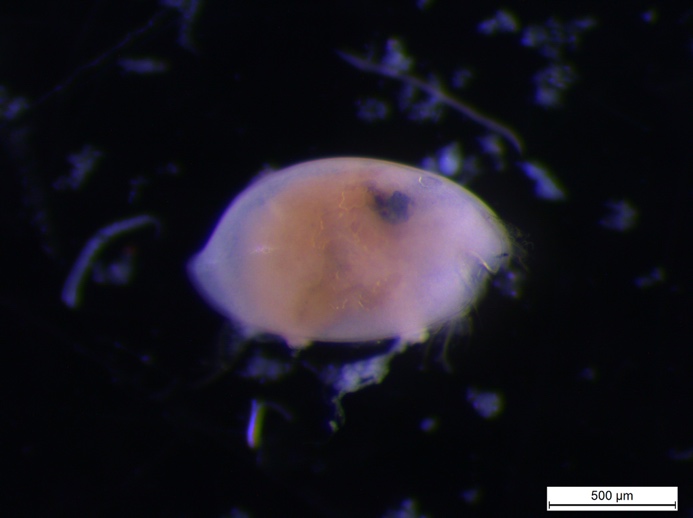
A bioluminescent ostracod (Myodocopida),
also known as a seed shrimp.
Santa Catalina Island, CA is home to many species of zooplankton. Zooplankton are defined by an inability to control their movement against the influence of currents. These often-overlooked organisms generally go unnoticed, but they are incredibly important. Zooplankton are crucial nutritional intermediates that drive energy flow in marine ecosystems. They consume detritus, plants, algae, and small animals, and in turn are eaten by still larger organisms. They bridge the gap between lower levels of the food web and larger animals. As such, they are a crucial part of marine communities.
Coves along Santa Catalina Island’s coastline vary in environmental characteristics, including protection status, substrate type, and level of connectivity between each other. Since zooplankton aren’t able to control their movement against currents, intermixing occurs often between communities that are close to one another. This process can potentially limit the influences of local conditions on structuring communities.
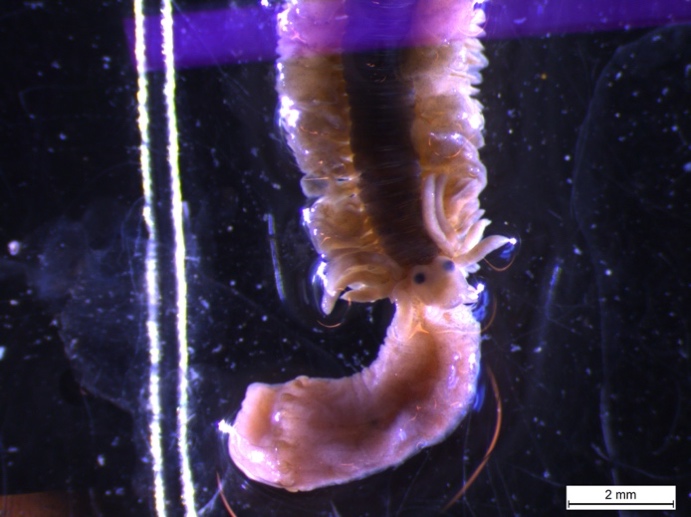
A polychaete worm (Phyllodocidae) everting
its pharynx.
Zooplankton communities can be described in several ways. Traditionally, the taxonomic identity of community members would be used to describe what composed a community. I took a different approach with my research and decided to analyze functional traits instead. This method considers the characteristics of an organism and how they inform its interactions with its ecosystem. Functional traits determine how zooplankton use and distribute energy and nutrients and impact other organisms. In conjunction with the classic taxonomic approach, I was able to produce a community analysis which helped me understand the ecological roles of zooplankton and how their communities varied around Catalina Island.
How do Catalina Island’s zooplankton communities vary?
I found that the functional composition and diversity of these zooplankton communities were consistent between distinct habitats along Catalina’s coastline. This indicates that the process of intermixing limits the influence of local conditions on communities. However, habitats in Marine Protected Areas, which are areas with regulated fishing and human activity, have higher taxonomic diversity than unprotected habitats. This project is ongoing as I continue to sort and identify zooplankton to describe these communities. My results will help expand our understanding of these communities and how their structure varies along coastlines.
What exactly are the zooplankton drifting all around us in the water?
We found 58 unique taxa in our samples and below we detail three especially interesting zooplankton.
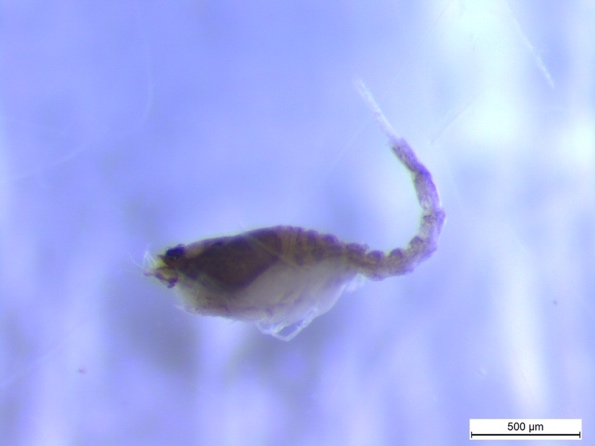 Cumella sp. (left) of the order cumacea, also known as comma shrimp due to their distinctive curve (though they are not true shrimp), were the most common taxa found in our samples. Cumacea are detritivores and suspension feeders that feed on organic materials and phytoplankton on the sea floor during the day and rise into the plankton at night. Organisms that exhibit this nocturnally planktonic habit are known as demersal plankton. Many plankton in Catalina are demersal including most amphipods, ostracods, polychaetes, tanaids, isopods, and harpacticoids. This is notable as these animals are accruing energy from or near the sea floor and are eaten in the water column, transferring energy from the sea floor to the plankton.
Cumella sp. (left) of the order cumacea, also known as comma shrimp due to their distinctive curve (though they are not true shrimp), were the most common taxa found in our samples. Cumacea are detritivores and suspension feeders that feed on organic materials and phytoplankton on the sea floor during the day and rise into the plankton at night. Organisms that exhibit this nocturnally planktonic habit are known as demersal plankton. Many plankton in Catalina are demersal including most amphipods, ostracods, polychaetes, tanaids, isopods, and harpacticoids. This is notable as these animals are accruing energy from or near the sea floor and are eaten in the water column, transferring energy from the sea floor to the plankton.
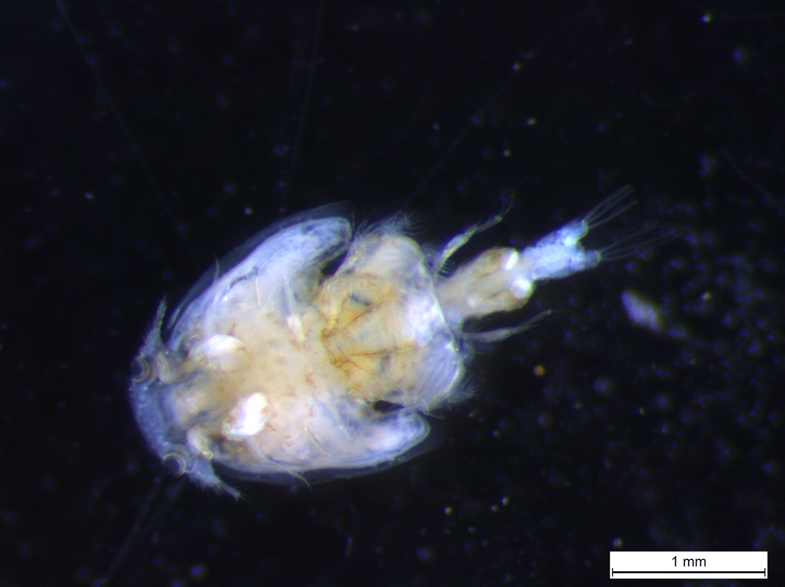 Caligid copepods (right) occupy the plankton throughout the day and night during their entire life. Plankton that remain suspended in the water across their life history are known as holoplankton. Caligidae are suctorial parasites of fishes. They latch onto fishes (the gills are a preferred local) and pierce their skin to extract fluids for nutrition. These vampiric crustacea will feed from a fish until it becomes weak and move onto a more suitable host to avoid killing hosts to maintain a stock of fishes to parasitize.
Caligid copepods (right) occupy the plankton throughout the day and night during their entire life. Plankton that remain suspended in the water across their life history are known as holoplankton. Caligidae are suctorial parasites of fishes. They latch onto fishes (the gills are a preferred local) and pierce their skin to extract fluids for nutrition. These vampiric crustacea will feed from a fish until it becomes weak and move onto a more suitable host to avoid killing hosts to maintain a stock of fishes to parasitize.
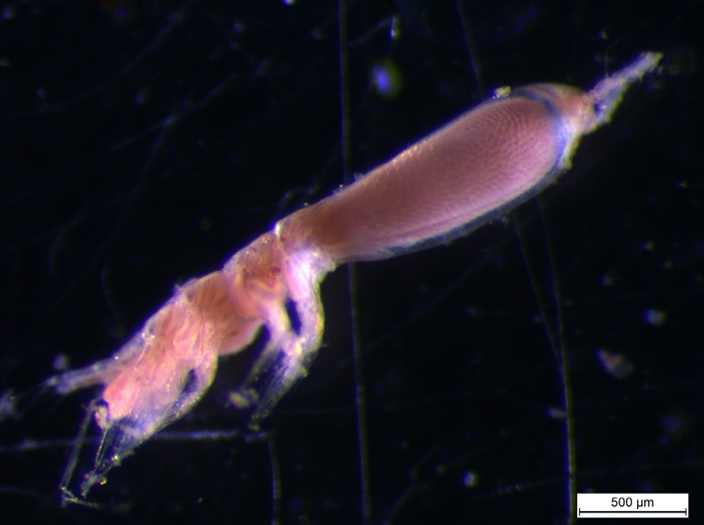 Monstrilloid copepods (left) are a unique taxon that are not well understood. This order of copepods exclusively occupies the plankton as reproductive adults before which they live as parasites of benthic invertebrates. Animals that only occupy the plankton during specific life history stages are known as meroplankton. Adults occupy the plankton to reproduce, brood eggs, and release larvae. During this reproductive phase they abstain from feeding. In fact, their mouths are even fused shut, making feeding entirely impossible.
Monstrilloid copepods (left) are a unique taxon that are not well understood. This order of copepods exclusively occupies the plankton as reproductive adults before which they live as parasites of benthic invertebrates. Animals that only occupy the plankton during specific life history stages are known as meroplankton. Adults occupy the plankton to reproduce, brood eggs, and release larvae. During this reproductive phase they abstain from feeding. In fact, their mouths are even fused shut, making feeding entirely impossible.
If you’re still curious about the incredible zooplankton that call Santa Catalina Island home, you can learn more here.
